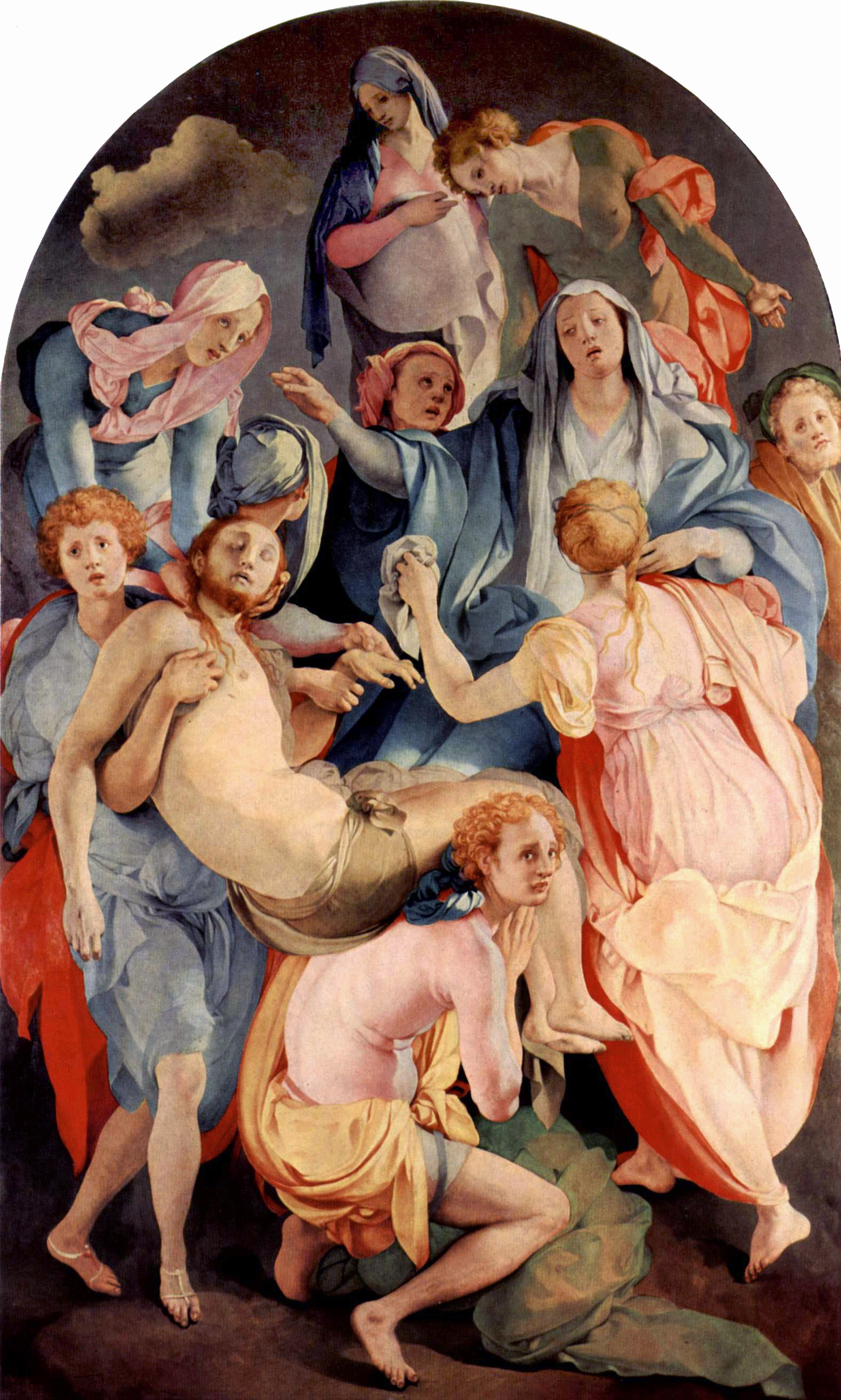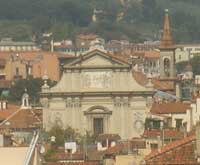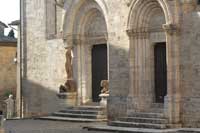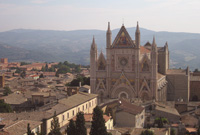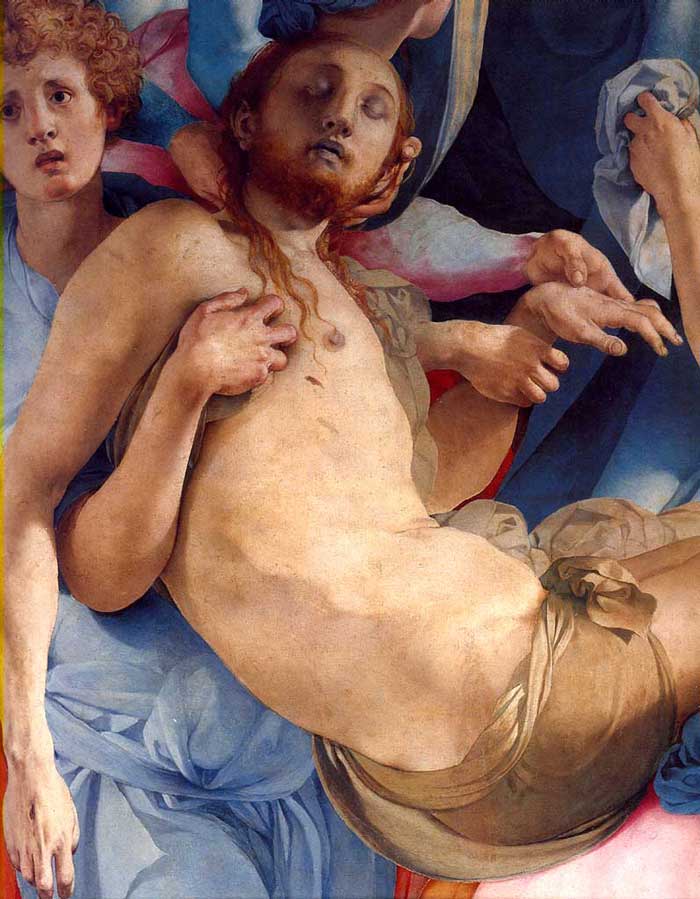 |
| Jacopo Pontormo, Deposition, detail, 1525-28, (panel), Capponi Chapel, Santa Felicita, Florence |
Jacopo Pontormo, frescoes in the Capponi Chapel, Santa Felicita, Florence |
| The Deposition from the Cross is an altarpiece by the Italian Renaissance painter Jacopo Pontormo, completed in 1528. It is broadly considered to be the artist's surviving masterpiece. Painted in oil on wood, The Deposition is located above the altar of the Capponi Chapel at the church of Santa Felicita, in Florence. |
|
||
Jacopo Pontormo, The Deposition from the Cross (1528). Oil on wood, 313 × 192 cm., Santa Felicità, Florence[2]
|
||
Pontormo's undulating mannerist contortions have been interpreted as intending to express apoplectic and uncontrolled spasms of melancholy.[1] The Virgin, larger than her counterparts, swoons sideways inviting the support of those behind her. The assembly looks completely interlocked, as if architecturally integrated. Legend has it that Pontormo set himself in self-portrait at the extreme right of the canvas; but ultimately, the most compelling and empathic figure is the crouching man in the foreground, whose expression mixes the weight of the cadaver and the weight of melancholy. he Deposition from the Cross is one of the standard scenes from the life of Jesus in medieval art, and because of the complexities of the composition, it is one in which Renaissance artists continued to take a great interest. Several years prior to Pontormo's masterpiece, the Florentine painter Rosso Fiorentino had painted a more phantasmagorical and gymnastically challenged array in his crowded version of the descent from the cross, the Deposition of 1521. Pontormo's grieving crowds and brightness of color also provide a stark contrast to Caravaggio's somber Deposition from the Cross or Entombment in the Vatican Pinacoteca. The Deposition by Raphael in the Galleria Borghese shows a later, though related scene: the Entombment of Christ. In addition to works of the same subject by other artists, Pontormo's own work from the time provides a useful comparison. The decoration in the dome of the Capponi chapel is now lost, but four roundels with the Evangelists still adorn the pendentives, which were painted by both Pontormo and his apprentice Bronzino. The swathed drapery inThe Visitation[1] (1529) in the church of San Michele e Francesco at Carmignano bears a striking resemblance to that in the Deposition. The contrapposto of the figures can be compared to Pontormo's Annunciation (1520s) frescoed on the adjacent wall. |
||
|
||
|
||
|
||
|
||
Il Restauro
|
||
[2] |
||
|
||
|
||
|
||
Pontormo (Jacopo Carucci), The Archangel Gabriel, modello for the fresco in the Capponi Chapel, S. Felicita, Florence, c. 1527-28, (black chalk, brown wash, traces of red chalk, white heightening, squared, 391 x 215 mm.), Gabinetto dei Disegni, Uffizi, Florence |
||
[2] The Yorck Project (2002) 10.000 Meisterwerke der Malerei (DVD-ROM), distributed by DIRECTMEDIA Publishing GmbH. ISBN: 3936122202., Public Domain
|
||||
Mannerism: Bronzino (1503–1572) and his Contemporaries | Derived from the Italian maniera, used by sixteenth-century artist and biographer Giorgio Vasari, the term Mannerism refers to the movement in the visual arts that spread through much of Europe between the High Renaissance and Baroque periods. It originated in Italy, where it lasted from about 1520 to 1600, and can be described as "mannered" in that it emphasized complexity and virtuosity over naturalistic representation. While the formal vocabulary of Mannerism takes much from the later works of Michelangelo (1475–1564) and Raphael (1483–1520), its adherents generally favored compositional tension and instability rather than the balance and clarity of earlier Renaissance painting. Some characteristics common to many Mannerist works include distortion of the human figure, a flattening of pictorial space, and a cultivated intellectual sophistication. |
||||
|
This article incorporates material from the Wikipedia articles Pontormo, Barbadori Chapel, published under the GNU Free Documentation License. |
||||
Podere Santa Pia, a wonderful farmhouse, located close to the historical village of Montalcino, has been skilfully restored respecting the original style and features, but also offering all the modern comforts. It is situated in a very panoramic and tranquil position. And although Santa Pia is off the beaten track it is the ideal choice for those seeking a peaceful, uncontaminated environment, yet still within easy reach of the the famous Tuscan wines. Brunello di Montalcino, perhaps Italy's best-known wine region, makes a good starting place for a wine tasting tour. Castello Banfi is within easy reach and Montalcino is only 28 kms away. Holiday accomodation in Tuscany | Podere Santa Pia | Artist and writer's residency |
||||
Podere Santa Pia |
Podere Santa Pia, garden view, December |
The façade and the bell tower of San Marco in Florence |
||
Pienza |
Montalcino |
San Quirico d'Orcia |
||
Florence, Duomo |
Orvieto, Duomo |
Monte Christo, evening sunset |
||
| The Barbadori Chapel, later Capponi Chapel, is a chapel in the church of Santa Felicita in Florence, central Italy. It was designed by Filippo Brunelleschi, and was later decorated by a cycle of works by the Mannerist painter Pontormo. Bartolomeo Barbadori commissioned the construction of a family chapel in the church around 1420. After the destruction of the Ridolfi chapel in San Jacopo sopr'Arno, this chapel is the oldest existing among those designed by Brunelleschi. Dedicated to the Virgin, it was most likely built to honor a fresco of the Annunciation, painted on the counter-façade. In the same point Pontormo frescoed the same subject. In 1487 the chapel was acquired by Antonio Paganelli, whose heir Bernardo Paganelli, in 1525, sold it to the Capponi family. The latter had it restored and decorated by Jacopo Pontormo, with help from a young Agnolo Bronzino. In 1722 Ferrante Capponi had the chapel restored again, adding a new altar with polychrome marble and closing it with a wrought iron enclosure which is still existing. A tondo by Pontormo, depicting the Madonna with Child, was perhaps moved in this period from the chapel to the Capponi private palace. Architecture The chapel was built by Brunelleschi in the period in which he was active in the Spedale degli Innocenti, and was still supporting the feasibility of the dome of Santa Maria del Fiore. He had already studied a reduced version of his subject for the latter in the dome of the Ridolfi Chapel and repeated it in the Barbadori Chapel, though now his design has been hidden by later reconstructions. Originally, the semi-spherical dome was supported by a cubic hall with four pendentives between the round arches of the walls. In each of the pendentives was a blind circular window, now replaced by the frescoes by Pontormo and Bronzino. Also a new feature for the time was the use of double Ionic semicolumns, instead of the traditional Gothic pilasters. The two columns, on the external side, are supported by angular Corithian pilasters. The theme, already used for the portico of the Spedale degli Innocenti, was repeated by Brunelleschi with little variants in the Sagrestia Vecchia and the Pazzi Chapel. Paintings and other artworks At the high altar, enclosed in its original 16th century frame, is the masterwork of the Mannerist painter Pontormo, depicting the Deposition from the Cross, executed from 1525 to 1528. On the western wall are other works by Pontormo, the Annunciation and the three Evangelists in the dome's pendentives. St. Mark is a work by Agnolo Bronzino. The fresco on the vault is lost. The tabernacle was designed by Jacopo Barozzi da Vignola. In its antependium was Pontormo's Madonna with Child, now in a private chapel in the Palazzo Capponi delle Rovinate
|
||||

